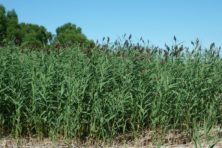Letter to the Editor: Noxious Weed Ordinance Is Work in Progress
- Share
- Tweet
- Pin
- Share
Hello to all, as you are crafting Bailey Harbor’s Noxious Weed Ordinance – I implore you to consider adding invasive cattails and hybrid cattails to the Noxious Weed Ordinance. Typha angustifolia (invasive cattails) and Typha x glauca (hybrid cattails) are listed in DNR NR 40.05 and are items #44 and #45 on the DNR’s Restricted list (NR40.05).
Narrow leaf cattails and hybrid cattails are a destructive force with which to be reckoned! Either the town works to remove this invasive and hybrid species now or it most certainly will be forced to in the future. DNR saw the need to eradicate invasive cattails when it chemically treated invasive and hybrid cattails in the Horicon Marsh. If someone is opposed to chemical treatment, cattails can be removed manually. Cattails are a growing problem. Baileys Harbor administrators – be proactive and work with landowners to improve the shoreline and rid it of invasive and hybrid cattails!
The township has a public viewing area across from Ridges Sanctuary. As more people visit the Sanctuary, they walk across the road to the public viewing area. But what are they viewing? Not beautiful Baileys Harbor! The public sees six- to 10-feet-tall, thick stands of cattails! The town is receiving more visitors. Encourage this prosperity, improve the public viewing areas – get rid of invasive cattails.
Cattails break off of one landowner’s property only to float in the water and adhere to another landowner’s property. Therefore, it is necessary for the state, county, township, Ridges Sanctuary, and private property owners to work together to treat invasive cattails.
Township of Baileys Harbor, I beseech you to include Typha angustifolia (invasive cattails) and Typha x glauca (hybrid cattails) in the Baileys Harbor Noxious Weed Ordinance. This is forward thinking and we all will be better for it.
Barbara Erlenborn
Baileys Harbor, Wis.

